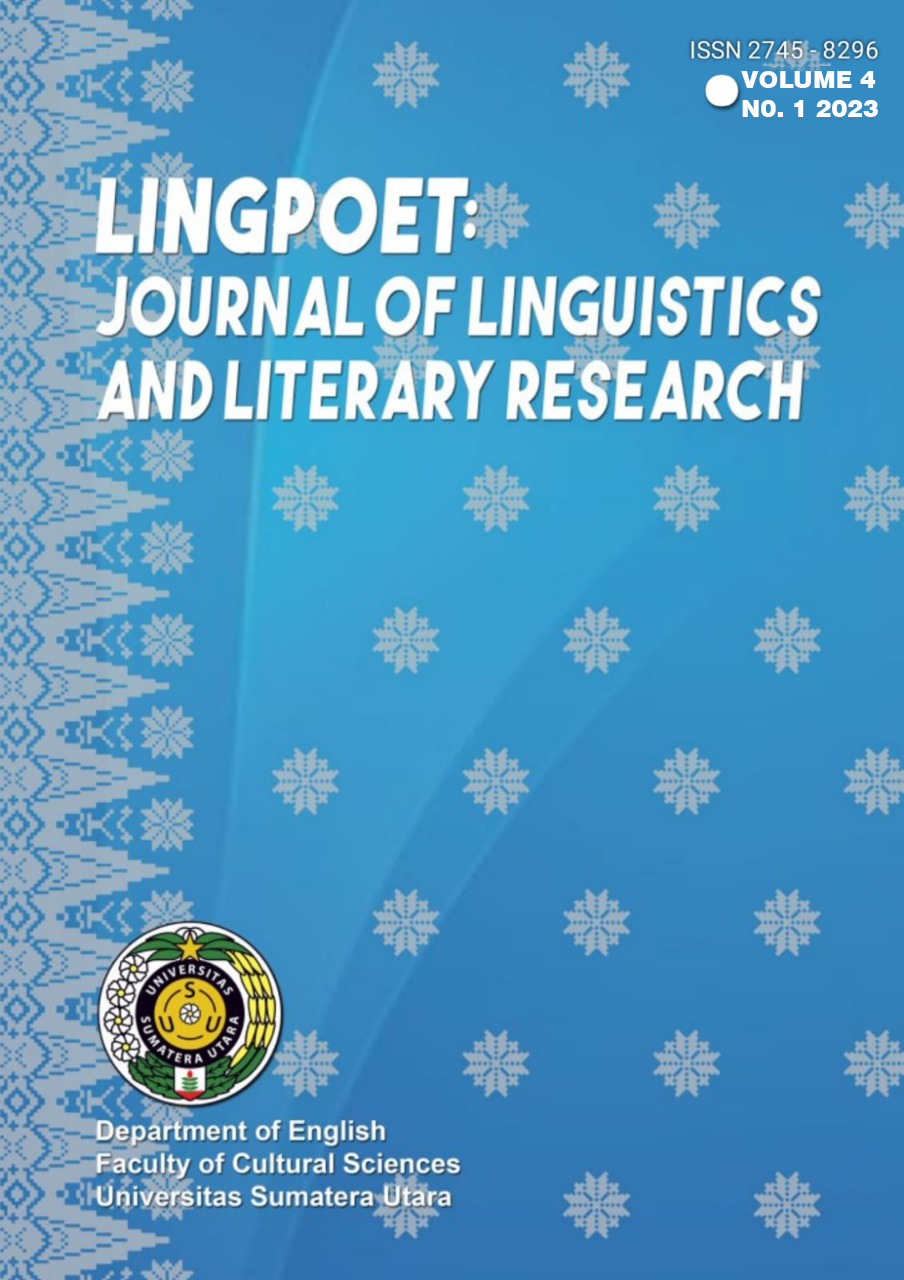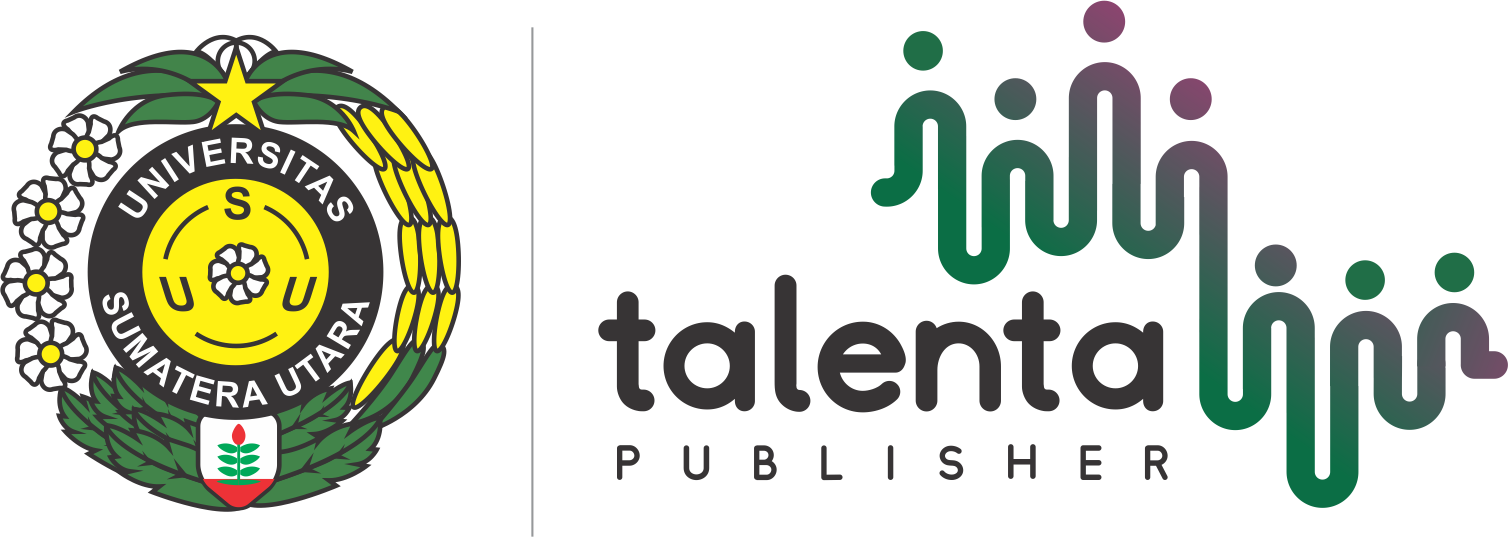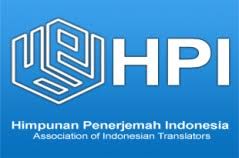Code-Switching used by Putri Tanjung and Boy William in Ngobrol Sore Semaunya’s Episode 2
DOI:
https://doi.org/10.32734/lingpoet.v4i1.9607Keywords:
Code, Code-switching, Utterance, Multilingualism, PodcastAbstract
This study wants to investigate the code-switching that occurred in the Podcast
Ngobrol Sore Semaunya’s Podcast Episode 2. This study also aims to describe the types of
code-switching, the factors causing the code-switching, and the function of code-switching
that occurred in the Podcast Ngobrol Sore Semaunya Episode 2. This study used qualitative
descriptive research. The object of this research is a data containing code-switching in
speech events on the Podcast Ngobrol Sore Semaunya Episode 2. The result showed three
results. The first type of code-switching that occurs according to Stockwell (2007) there
are, 1) tag-switching, 2) intra-sentential switching, 3) inter-sentential switching. Second, the
reason that causes code-switching according to Hoffman (1991), there are 1) talking about
particular topic, 2) quoting somebody else, 3) express solidarity, 4) interjection, 5)
repetition used for clarification, 6) intention of clarifying the speech content for the
interlocutor and, 7) expressing group identity. The last is the code-switching function
according to Gumperz (1982), there are 1) quotation, 2) addressee specification, 3)
interjection or sentence filler, 4) reiteration, 5) message qualification, and 6) objectification.
Downloads
References
G. Salmon and P. Edirisingha, Podcasting for Learning in Universities. Maidenhead: Open University Press, McGraw-Hill Education, 2008.
B. Phillips, “Student-produced Podcasts in Language Learning–Exploring Student Perceptions of Podcast Activities,†IAFOR J. Educ., 2005, [Online]. Available: https://iafor.org/journal/iafor-journal-of-education/volume-5-issue-3/article-8/
D. L. Putri, “Alih Kode dalam Acara Talk Show ‘SHOW IMAH’ di TRANS TV 2012,†Universitas Negeri Yogyakarta, Yogyakarta, 2013. [Online]. Available: https://eprints.uny.ac.id/17996/
I. Nafi’ah, “An Analysisi of Code-Switching in the Novel Miss Pesimis by Alia Zalea,†STAIN Tulungagung, Tulungagung, 2013. [Online]. Available: http://repo.iaintulungagung.ac.id/583/1/Skripsi%20inganatun%20nafi%27ah%203213063053%20TBI.pdf
D. Nuryanti, “Alih Kode Bahasa Inggris-Indonesia dalam Kelas Percakapan Bahasa Inggris di Akademi Bahasa Asing Bina Sarana Informatika Jakarta,†Universitas Indonesia, Depok, 2010. [Online]. Available: https://scholar.google.co.id/citations?view_op=view_citation&hl=id&user=P84 XOy4AAAAJ&citation_for_view=P84XOy4AAAAJ:u-x6o8ySG0sC
R. Wardhaugh, An Introduction to Sociolinguistics, 5th ed. London: Blackwell, 2006. [Online]. Available: http://staffnew.uny.ac.id/upload/132107096/pendidikan/Book+for+Sociolinguisti cs.pdf
J. Swann, T. Lillis, and R. Mesthrie, A Dictionary of Sociolinguistics. London: Edinburgh University Press, 2004. [Online]. Available: https://www.damanhour.edu.eg/pdf/738/A%20Dictionary%20of%20Sociolinguistics.pdf
C. Myers-Scotton, Multiple Voices: Introduction to Bilingualism. London: Blackwell, 2006. [Online]. Available: https://vulms.vu.edu.pk/Courses/ENG512/Downloads/%5BCarol_Myers- Scotton%5D_Multiple_Voices_An_Introduc(BookFi).pdf
V. Fromkin, R. Roman, and N. Hyams, An Intrododuction to Language 10th ed. New York: Michael Rosenberg Publisher, 2013. [Online]. Available: https://ukhtt3nee.files.wordpress.com/2019/04/an_introduction_to_language.pdf
S. Mahootian, “Code Switching and Mixing,†Keith Brown Ed.- InChief Encycl. Lang. Linguist., vol. 2, 2006, [Online]. Available: https://www.researchgate.net/publication/291108660_Code_Switching_and_Mixing
J. MacSwan, “A Minimalist Approach to Intrasentential Code-Switching,†Ital. J. Linguist., vol. 17, no. 1, 2005, [Online]. Available: https://www.researchgate.net/publication/228524688_A_Minimalist_Approach_to_Intrasentential_Code-Switching
A. Yıltanlılar and C. K. Çağanağa, “The Perceptions of EFL Teachers on the Impact of the Usage of Code-Switching in EFL Classroom Management,†Open Access Libr. J., 2015.
P. Stockwell, Sociolinguistics: A Resource Book for Students (2nd ed.). London: Routledge, 2007. [Online]. Available: https://www.routledge.com/Sociolinguistics-A-Resource-Book-for-Students/Stockwell/p/book/9780415401272
T. Martiana, “Examing Code-Switching Practice in Hilman Hariwijaya’s: Makhluk Manis dalam Bisdan Bunga untuk Poppi,†J. Univ., vol. 1, no. 1, pp. 9–20, 2013.
M. L. Girsang, “An Analysis of Code Switching and Code Mixing as Found in Television Advertisement,†2015. [Online]. Available: https://www.uhn.ac.id/files/akademik_files/1712071009_2015_The%20%20Explora%20%20Journal%20%20Journal%20of%20English%20%20Language%20Teaching%20(ELT)%20and%20Linguistics_3.%20An%20Analysis%20of%20Code%20Switching%20and%20Code%20Mixing%20as%20Found%20in%20Television%20Advertisement.pdf
J. J. Gumperz, Discourse Strategies (1st ed.). New York: Cambridge University Press, 1982.
J. F. Hamers and M. H. A. Blanc, Bilinguality and Bilingualism (2nd ed.). New York: Cambridge University Press, 2000.
J. Holmes, An Introduction to Sociolinguistic (4th ed.). London: Routledge, 2013.
C. Hoffman, An Introduction to Bilingualism. New York: Longman, 1991.
J. W. Creswell, RESEARCH DESIGN: Qualitative, Quantitative, and Mixed Methods Aproaches, Fourth Edi, 4th ed. SAGE Publication, 2014.
N. Mack, C. Woodsong, G. Guest, and E. Namey, Qualitative Research Methods: A Data Collector’s Field Guide. USA: Family Health International (FHI), 2005.
Downloads
Published
How to Cite
Issue
Section
License
Copyright (c) 2023 LingPoet: Journal of Linguistics and Literary Research

This work is licensed under a Creative Commons Attribution-ShareAlike 4.0 International License.













